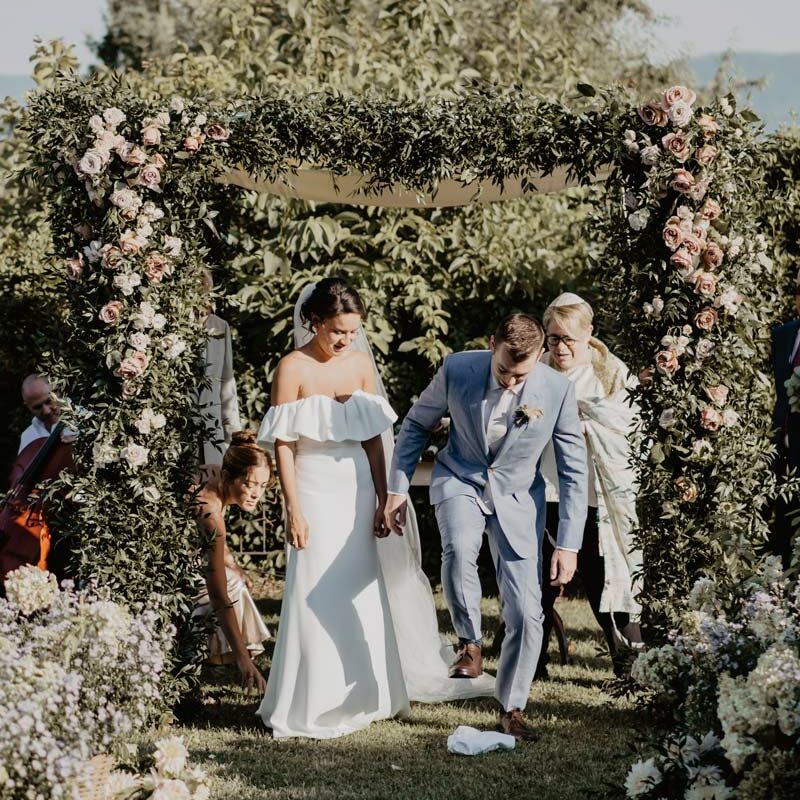Jewish
Smash the glass!!!
1. Aufruf
Aufruf is a Yiddish term that means “to call up.” It is the blessing called Aliyah that the bride and groom are called to the Torah.
After the Aliyah the rabbi will offer a blessing called misheberach and usually the guests shower the couple with candies to wish them a sweet life together.
2. Ketubah Signing
The ketubah is a symbolic Jewish marriage contract that outlines the groom’s responsibilities to his bride. It dictates the conditions he will provide in the marriage, the bride’s protections and rights, and the framework should the couple choose to divorce. Ketubahs are part of Jewish civil law—so there’s no mention of God, but it is a contract between the bride and the groom . The ketubah is signed by the couple and two witnesses before the ceremony takes place, with the rabbi, then is read to the guests during the ceremony.
3. Bedeken
During the ketubah signing, the groom approaches the bride for the bedeken, or veiling. He looks at her and then veils her face. This signifies that his love for her is for her inner beauty, and also that the two are distinct individuals even after marriage. This tradition comes from the Bible wherein Jacob was tricked into marrying the sister of the woman loved because was veiled and didn’t recognize her.
4. The walk to the chuppah
In Jewish ceremonies, the processional and recessional order is slightly different than traditional non-Jewish ceremonies. In the Jewish tradition, both of the groom’s parents walk him down the aisle to the chuppah. The bride and her parents follow.
Traditionally, both sets of parents stand under the chuppah during the ceremony, alongside the bride, groom, and rabbi.
5. Ceremony under the chuppah
A chuppah has four corners and a covered roof to symbolize the new home the bride and groom are building together. In some ceremonies, the four posts of the chuppah are held up by friends or family members throughout the ceremony, supporting the life the couple is building together, while in other instances it may be a freestanding structure decorated with flowers. The canopy is often made of a tallit, or prayer shawl, belonging to a member of the couple or their families.
6. Circling
In the Ashkenazi tradition, the bride traditionally circles around her groom either three or seven times under the chuppah. Some people believe this is to create a magical wall of protection from evil spirits, temptation, and the glances of other women. Others believe the bride is symbolically creating a new family circle.
7. Ring exchange
Traditionally, Jewish brides get married in a wedding band that is made of metal (gold, silver, or platinum) with no stones. In ancient times, the ring was considered the object of value or “purchase price” of the bride.
8. Sheva b’rachot: seven blessings
The seven blessings, called the Sheva B’rachot, come from ancient teachings. They are often read in both Hebrew and English, and shared by a variety of family members or friends, just as friends and family are invited to perform readings in other types of ceremonies. The blessings focus on joy, celebration, and the power of love. They begin with the blessing over a cup wine, then progress to more grand and celebratory statements, ending with a blessing of joy, peace, companionship, and the opportunity for the bride and groom to rejoice together.
9. Breaking of the glass
As the ceremony comes to an end, the groom (or in some instances the bride and groom) is invited to step on a glass inside a cloth bag to shatter it. The breaking of the glass holds multiple meanings. Some say it represents the destruction of the Temple in Jerusalem.
Others say it demonstrates that marriage holds sorrow as well as joy and is a representation of the commitment to stand by one another even in hard times.
The cloth holding the shards of glass is collected after the ceremony, and many couples choose to have it incorporated into some sort of memento of their wedding day.
10. Mazel tov!
Shouting “Mazel tov!” is one of the most well-known Jewish wedding rituals. Once the ceremony is over and the glass is broken, you will hear guests cheer “Mazel tov!” Mazel tov has a similar meaning “good luck” or “congratulations”.
11. Hora and mezinke
The celebratory dance at the reception is called the hora where guests dance in a circle. Oftentimes, you will see women dancing with women and men dancing with men. The bride and groom are seated on chairs and lifted into the air while holding onto a handkerchief or cloth napkin. There is also a dance called the mezinke, which is a special dance for the parents of the bride or groom when their last child is wed.



